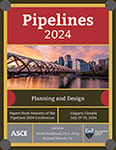Analysis of Field Downhole Annular Pressure Data in HDD Operations
Publication: Pipelines 2024
ABSTRACT
Current hydraulic fracture models to estimate the maximum allowable annular drilling fluid pressure (formation limit pressure) before hydrofracture or blowout will occur during horizontal directional drilling (HDD) operations are largely based on cavity expansion theory. The most common of the models employed in the HDD industry is the Delft equation, which was developed by Luger and Hergarden. However, since then, numerous methods have been proposed which produce a wide range of potential maximum annular pressures that should be applied in design. This paper explores some of the more common formation limit pressure models and identifies which model appears to better predict the actual maximum formation limit pressure based on downhole annular pressure data collected in HDD pilot hole operations in cohesive soils where we observed inadvertent returns (IR) of drilling fluid. Based on the analysis and data comparison presented in this paper, it was concluded that the cavity expansion theory for undrained soils and the Queen’s model provide realistic predictions of formation limit pressures in clays.
Get full access to this chapter
View all available purchase options and get full access to this chapter.
REFERENCES
Bennett, D., and Wallin, K. (2008). “Step-by-step Evaluation of Hydrofracture Risks for HDD Projects.” No-Dig 2008. Paper A-3-01.
Bourgoyne, A. T., et al. (1991). Applied Drilling Engineering. Society of Petroleum Engineers.
Gibson, R. E., and Anderson, W. F. (1961). “In-Situ Measurement of Soil Properties with the Pressuremeter.” Civil Engineering and Public Works Review. Vol. 56 No. 658.
Ladd, C. C. (1964). “Stress-Strain Behavior of Saturated Clay and Basic Strength Principles.” US Army Engineer Waterways Experiment Station. Research Report R64–17.
Luger, H. J., and Hergarden, H. J. A. M. (1988). “Directional Drilling in Soft Soils: Influence of Mud Pressures.” No-Dig 1988. Paper 6B.
Marchi, M., Gottardi, G., and Soga, K. “Fracturing Pressure in Clay.” Journal of Geotechnical and Geoenvironmental Engineering Volume 140, Issue 2. DOI: https://doi.org/10.1061/(ASCE)GT.1943-5606.0001019.
Staheli, K., Bennett, R. D., O’Donnell, H. W., and Hurley, T. J. (1998). “Installation of Pipelines beneath levees using horizontal directional drilling.” Technical Report CPAR-GL-98-1, US Army Engineer Waterways Experiment Station, Vicksburg, MS.
Staheli, K., Price, C., and Wetter, L. (2010). “Effectiveness of Hydrofracture Prediction for HDD Design.” Proceedings of 2010 No-Dig Conference, Chicago, Illinois, May 2-7, 2010.
USACE. (2020). “Conduits, Pipes, and Culverts Associated with Dams and Levee Systems.” Engineer Manual EM 1110-2-2902.
Vesic, A. S. (1972). “Expansion of Cavities in Infinite Soil Mass.” Journal of the Soil Mechanics and Foundations Division. Proceedings of the American Society of Civil Engineers. 98(3), pp. 265–290.
Xia, H., and Moore, I. D. (2006). “Estimation of Maximum Mud Pressure in Purely Cohesive Material during Directional Drilling.” Geomechanics and GeoEngineering, Vol. 1, pp. 3–11. DOI: https://doi.org/10.1061/(ASCE)GM.1943-5622.000080.
Information & Authors
Information
Published In
History
Published online: Aug 30, 2024
Authors
Metrics & Citations
Metrics
Citations
Download citation
If you have the appropriate software installed, you can download article citation data to the citation manager of your choice. Simply select your manager software from the list below and click Download.
